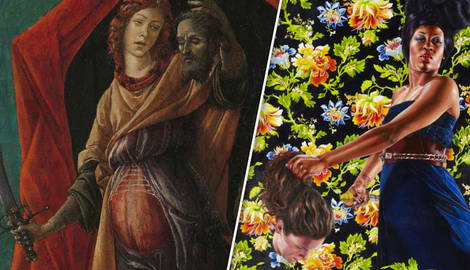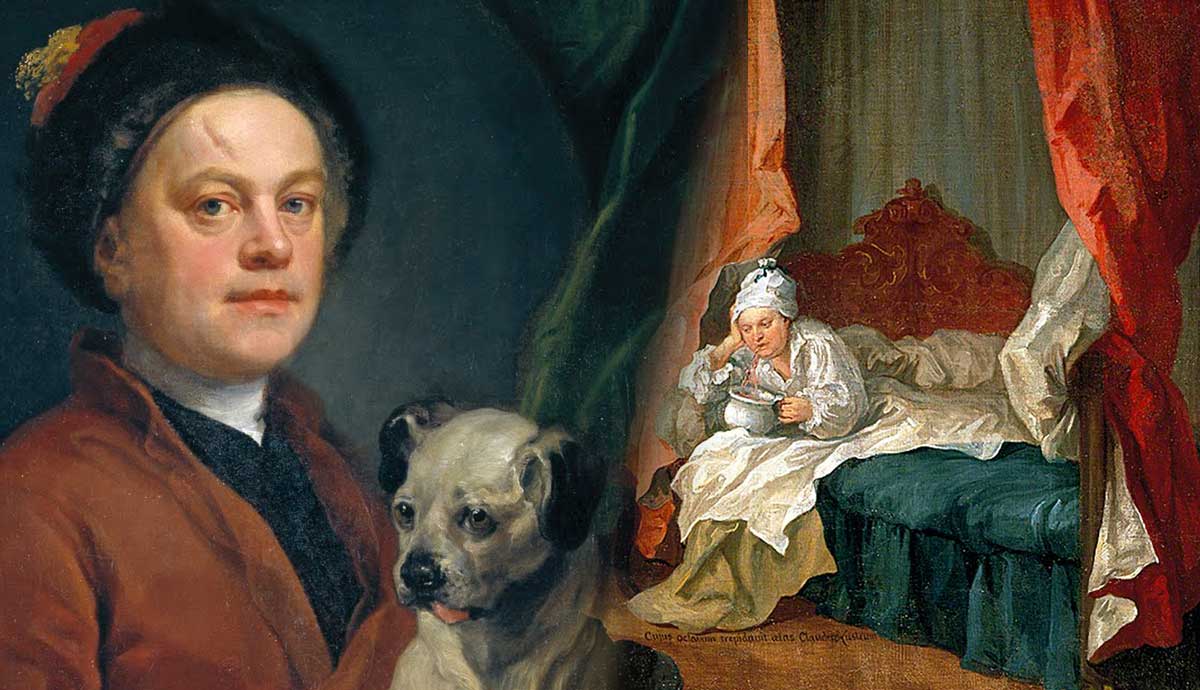
Judith slaying Holofernes is a biblical story that has been famous in art throughout the ages. The story is centered around Judith, a beautiful Jewish woman from the city of Bethulia. Bethulia had recently been besieged by the Assyrian general Holofernes. Judith feigns an attempt at escaping the city by leaving and claiming to foretell Holofernes’ victory. For this, she is invited into his tent at the camp outside of Bethulia. While he is in a drunken state, Judith beheads him. She brings his head back to the city for all to see.
10. Judith by Jan Sanders van Hemesse

Judith Slaying Holofernes is a biblical story often depicted on canvas. The depictions of Judith’s story vary, depending on the artist, their backstory, and the time period in which the artwork was made. Some show Judith as violent, accomplished, anxious, or seductive. Despite the variations, Judith’s story has served as an inspiration to women and artists for centuries.
Jan Sanders van Hemessen chose to depict Judith as entirely nude in his painting titled Judith. Her muscles bulge as she brandishes her sword, raising it triumphantly above her head as the severed head of Holofernes lies next to her. Her other hand grasps the bag she will put the severed head in to return to Bethulia. She twists to confront the viewer, creating a sense of tension.
Her nakedness recalls the reason she was in the tent—to seduce Holofernes and slay him while his guard was down. It could also be an evocation of the ancient Greek ideal of athleticism in men while Judith plays the masculine role of the dominator. To recall ancient Greek values in art was a sign of the artist’s classical knowledge, and with that came a sense of sophistication. Jan Sanders van Hemessen was active in the Netherlands but was trained in the classical painting style and was heavily inspired by Italian Renaissance artists such as Michaelangelo and Raphael.
9. Judith with the Head of Holofernes by Sandro Botticelli

Sandro Botticelli’s Judith with the Head of Holofernes, circa 1497, shows Judith much more boldly than other depictions do. In this painting, Judith exits Holofernes’ tent, lifting his severed head to her eye level, proudly strutting with the sword in her other hand. There is no apparent worry about getting away from the camp undetected. Judith’s mouth is parted, so it can be assumed that she is bold enough to speak as she holds it up for all to see, calling attention to her actions. Though her dress’s laces are undone, her dress’s fabric is blowing gracefully behind her. To gain access to the enemy, she needed to seduce the general, yet Judith is properly hailed in art as a hero for her bravery and calculative skills.
8. Judith in the Tent of Holofernes by Johann Liss

Judith in the Tent of Holofernes by Johann Liss shows Judith stuffing the head of the dead general into a sack held by her maid. Judith’s dress is in disarray, her cheeks glowing pink, and her lips shining with moisture. The sensuality of her expression, as she looks back at the viewer, reminds the audience of the intimate nature of the assassination and that Holofernes’ follies allowed Judith to pursue her intentions.
The artwork moves in a circle. The beheading has already occurred, and the outcome confronts us with a horror scene, yet the killer’s face is illuminated and draws the viewer’s attention as the focal point. The illuminated face is quickly followed by a question of what the figure is doing, leading us down her arm and to the severed head hidden in the shadows. Open and raw, it is a stark reminder of the gruesomeness of the situation.
Holofernes’ body is a striking juxtaposition to Judith’s. While Judith’s pose is full of action, Holofernes’ body looks limp and headless. He appears as if he is about to fall from the bed. The neck wound is fresh, just beginning to bleed down his arm.
7. Judith and Holofernes by Giorgio Vasari

In Giorgio Vasari’s Judith and Holofernes, the scene that is painted shows the time before the bloodshed occurred. The scene is violent, with a muscular Judith holding Holofernes’ head down on the bed’s white sheets while raising a glinting sword above in preparation for the beheading she is about to complete. Her face is serene. She knows her duty and accepts it calmly for the sake of her home and her loved ones. Vasari could have painted her expression as calm in order to emphasize that Holofernes is in a drunken sleep, which makes the mission easy for her.
Her maid, Abra, is in the background, though it is unclear whether she is assisting in holding him down. Her clothing is reminiscent of the Virgin Mary, with her blue dress and a white veil. The sword that pauses over her head is curved and glints like a halo. Though the act is bloody, it is done for a just and holy cause. Judith is quoted as saying: See here, the head of Holofernes, the commander of the Assyrian army […]. The Lord has struck him down by the hand of a woman.
Vasari’s depiction shows Judith’s strength, resolve, and loyalty while keeping her composed and beautiful. She is shown as a woman capable of outsmarting her enemy with her wits, charisma, and self-control. When Vasari painted Judith and Holofernes, women were typically expected to be meek and docile caretakers within the confines of a domestic lifestyle. This story could have served as a reminder—or a warning—of women’s cunning and strengths against men who let their guards down.
6. Judith and Her Maidservant by Orazio Gentilesch

Orazio Gentileschi’s Judith and her Maidservant with the Head of Holofernes shows the moments after the beheading occurred. Judith and her maidservant look over their shoulders anxiously. They still hold the evidence of their actions. Judith’s hand is seen holding the sword, though she tucks it behind her body, while the maidservant holds the head of the deceased general. At this point in the story, they would have feared imprisonment as they returned to Bethulia with the severed head.
Their gaze watches for an unknown threat, inducing an uneasiness that leaves us sympathetic to the women despite the violence in their actions. It creates a shared apprehension that makes the viewer feel as if they are complicit. Orazio’s painting explores the emotions that the women must have felt as they attempted to get the head back to the city, which evokes a richly sympathetic atmosphere around the subjects of the painting. The background is relatively plain, forcing our attention onto the figures caught in a moment of fear.
5. Judith by Lucas Cranach the Elder

Lucas Cranach the Elder depicts Judith in contemporary clothing that people of wealth would have found fashionable. She is turned in a three-quarter turn, typical of portraiture in the 16th century. She proudly clutches the sword that she has used to cut off the head of Holofernes, a small smile on her lips as she peers at the viewer with confidence. She rests her arm on the enemy’s head, her hard-won prize that she means to show off. Portraiture was often used to show wealth, accomplishments, or social status. These things would have formed the core of a 16th-century person’s sense of identity, and this would have been common knowledge amongst the patrons viewing Cranach’s painting. In this portrait, Cranach says that Judith’s bravery is a part of her identity—she is the hero of the story.
4. Judith by Gustav Klimt

Gustav Klimt’s Judith is a seductive representation of Judith. It is literally coated in luxury. Gold leaf covers large areas of the painting, forming scale patterns, background trees, embroidery for Judith’s robe, and a golden necklace. Judith’s hair is piled neatly onto her head to make an impressively elegant hairstyle. She tilts her head back, peering at the viewer through heavy-lidded eyes. She is naked except for the sheer blue robe.
She is shown as gently holding Holofernes’ head under her arm, resting her fingers on his hair. However, the severed head takes only a tiny sliver of the painting and it is almost entirely out of view. In Klimt’s painting, Judith is the sole center of the artwork. The seductive expression she holds on her face has been described by the art critic, Franz A.J. Szabo, as a triumph of the erotic feminine principle over the aggressive masculine one. In this painting, her seductive qualities do not come from her sense of duty, but rather from the thrill of experiencing feminine dominance over the aggressive masculinity that has dominated the world for centuries.
3. Judith and Holofernes by Kehinde Wiley

Kehinde Wiley depicts Judith as a powerful Black woman, holding a head modeled by an assistant to the artist. It is inspired by Giovanni Baglione’s painting, also titled Judith and Holofernes from c. 1608. It is common for the figures in Wiley’s paintings to be based on people that he meets in life. Judith is modeled after a woman he met at the mall while shopping. It is typical of his work to blend urban and classical styles, showing modern people from shopping malls as characters from the Bible.
The background of the painting is black, with brightly colored flowers patterned on top. It is a high-contrast painting in color and subject, as Wiley changes historically white-centered paintings and subverts them with depictions of Black people. Not only does Wiley re-imagine white-centric stories to combat structural racism in the United States, but he has also helped change the future of art history by creating the official portrait of American President Barack Obama.
2. Judith Beheading Holofernes by Caravaggio

Carvaggio’s Judith Beheading Holofernes is one the best-known depictions of the story. Although the story had been depicted in art before the late 16th century, Caravaggio was among the first to create such a violent and bloody scene in its depiction. It was shocking then to see the gruesome act as it was occurring and to be confronted with the gore. Holofernes’ blood sprays thickly onto his pillow as the blade slices into his flesh. Judith’s posture and facial expression are at odds. She holds herself at a distance, recoiling at the sight of blood, but her brow is furrowed in concentration. Despite her feelings about the task she feels compelled to complete, she is resolved.
Her maid, Abra, stands beside her with a bag, waiting for the head to be severed so that they may escape and return to the city of Bethulia. Traditionally, Abra is shown as a young woman, but Caravaggio made her an old woman. She watches intensely as Holofernes twists his body to look at his attackers in his last moments. Caravaggio’s painting techniques inspired many future artists—especially his use of tenebrism, which introduced the severe darks and lights in his paintings to the broader art world. Artists like Artemisia Gentileschi would be heavily inspired by his work.
1. Judith Beheading Holofernes by Artemisia Gentilschi

Artemisia Gentileschi’s Judith Beheading Holofernes is another violent depiction of the story. Judith and her maid are shown with their sleeves rolled up in order to hold Holofernes down with force. Judith grabs the side of his face to hold his head while she slices the blade through his throat. Blood spurts in all directions, traveling toward Judith’s dress. Holofernes is wrapped in his blankets, caught off guard by the attack, yet he attempts to push his attackers away by raising an arm towards the maid. The blood begins to soak into the sheets under his body, dripping down the side of the bed.
The violence in Gentileschi’s depiction of Judith and Holofernes is often noted alongside her personal experience with sexual assault. There are surviving records of the court case during which Artemisia was subjected to torture by the court to ensure she was telling the truth about her assault. In the end, her rapist was convicted, but he wasn’t severely punished. The ferocity of the attack in Judith Beheading Holofernes is often viewed as a symbolic representation of female rage acquired through men’s oppressive abuse, both socially and personally.










